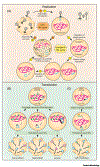The phages of staphylococci: critical catalysts in health and disease
- PMID: 34030968
- PMCID: PMC8578144
- DOI: 10.1016/j.tim.2021.04.008
The phages of staphylococci: critical catalysts in health and disease
Abstract
The phages that infect Staphylococcus species are dominant residents of the skin microbiome that play critical roles in health and disease. While temperate phages, which can integrate into the host genome, have the potential to promote staphylococcal pathogenesis, the strictly lytic variety are powerful antimicrobials that are being exploited for therapeutic applications. This article reviews recent insights into the diversity of staphylococcal phages and newly described mechanisms by which they influence host pathogenicity. The latest efforts to harness these viruses to eradicate staphylococcal infections are also highlighted. Decades of research has focused on the temperate phages of Staphylococcus aureus as model systems, thus underscoring the need to broaden basic research efforts to include diverse phages that infect other clinically relevant Staphylococcus species.
Keywords: SaPI; Staphylococcus; pathogenesis; phage; phage therapy; transduction.
Copyright © 2021 Elsevier Ltd. All rights reserved.
Conflict of interest statement
Declaration of interests There are no interests to declare.
Figures


Similar articles
-
Staphylococcus aureus Prophage-Encoded Protein Causes Abortive Infection and Provides Population Immunity against Kayviruses.mBio. 2023 Apr 25;14(2):e0249022. doi: 10.1128/mbio.02490-22. Epub 2023 Feb 13. mBio. 2023. PMID: 36779718 Free PMC article.
-
Strategies for Editing Virulent Staphylococcal Phages Using CRISPR-Cas10.ACS Synth Biol. 2017 Dec 15;6(12):2316-2325. doi: 10.1021/acssynbio.7b00240. Epub 2017 Sep 21. ACS Synth Biol. 2017. PMID: 28885820 Free PMC article.
-
Temperate Phages of Staphylococcus aureus.Microbiol Spectr. 2019 Sep;7(5):10.1128/microbiolspec.gpp3-0058-2018. doi: 10.1128/microbiolspec.GPP3-0058-2018. Microbiol Spectr. 2019. PMID: 31562736 Free PMC article. Review.
-
CRISPR-Cas10 assisted editing of virulent staphylococcal phages.Methods Enzymol. 2019;616:385-409. doi: 10.1016/bs.mie.2018.10.023. Epub 2018 Dec 17. Methods Enzymol. 2019. PMID: 30691652
-
Peculiarities of Staphylococcus aureus phages and their possible application in phage therapy.Appl Microbiol Biotechnol. 2019 Jun;103(11):4279-4289. doi: 10.1007/s00253-019-09810-2. Epub 2019 Apr 17. Appl Microbiol Biotechnol. 2019. PMID: 30997551 Review.
Cited by
-
Deciphering the Genetic Architecture of Staphylococcus warneri Prophage vB_G30_01: A Comprehensive Molecular Analysis.Viruses. 2024 Oct 19;16(10):1631. doi: 10.3390/v16101631. Viruses. 2024. PMID: 39459963 Free PMC article.
-
Biological function identification of phage holin Hol-4086 and treatment of Staphylococcus aureus infection.Front Microbiol. 2025 Feb 25;16:1499566. doi: 10.3389/fmicb.2025.1499566. eCollection 2025. Front Microbiol. 2025. PMID: 40071209 Free PMC article.
-
Bacteriophage infection drives loss of β-lactam resistance in methicillin-resistant Staphylococcus aureus.Elife. 2025 Jul 10;13:RP102743. doi: 10.7554/eLife.102743. Elife. 2025. PMID: 40637714 Free PMC article.
-
Genomic Characterization and Antimicrobial Susceptibility of Dromedary-Associated Staphylococcaceae from the Horn of Africa.Appl Environ Microbiol. 2022 Nov 8;88(21):e0114622. doi: 10.1128/aem.01146-22. Epub 2022 Oct 13. Appl Environ Microbiol. 2022. PMID: 36226992 Free PMC article.
-
Characteristics of a novel temperate bacteriophage against Staphylococcus arlettae (vB_SarS_BM31).Int Microbiol. 2023 May;26(2):327-341. doi: 10.1007/s10123-022-00292-3. Epub 2022 Nov 7. Int Microbiol. 2023. PMID: 36336729 Free PMC article.
References
-
- Parikka KJ et al. (2017) Deciphering the virus-to-prokaryote ratio (VPR): Insights into virus–host relationships in a variety of ecosystems. Biol. Rev 92, 1081–1100 - PubMed
-
- Suttle CA (2007) Marine viruses - Major players in the global ecosystem. Nat. Rev. Microbiol 5, 801–812 - PubMed
-
- Danovaro R et al. (2011) Marine viruses and global climate change. FEMS Microbiol. Rev 35, 993–1034 - PubMed
-
- Boyd EF and Brüssow H (2002) Common themes among bacteriophage-encoded virulence factors and diversity among the bacteriophages involved. Trends Microbiol. 10, 521–529 - PubMed
Publication types
MeSH terms
Grants and funding
LinkOut - more resources
Full Text Sources
Other Literature Sources
Medical

